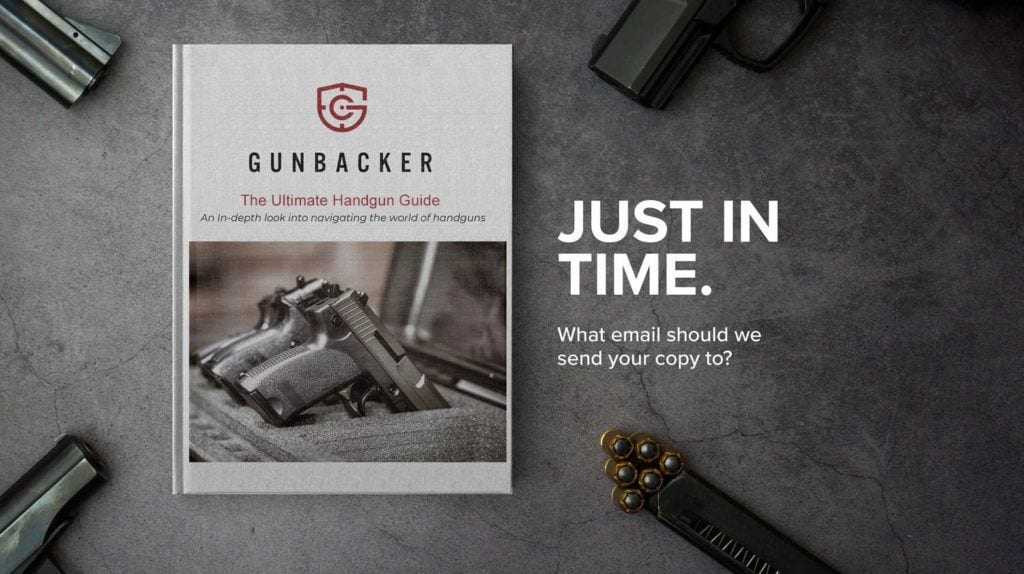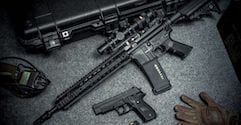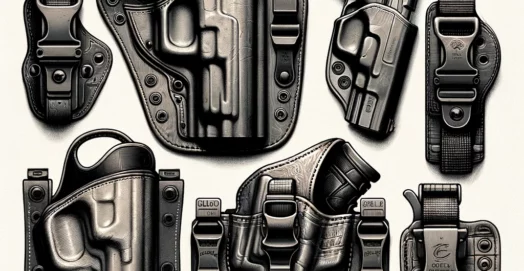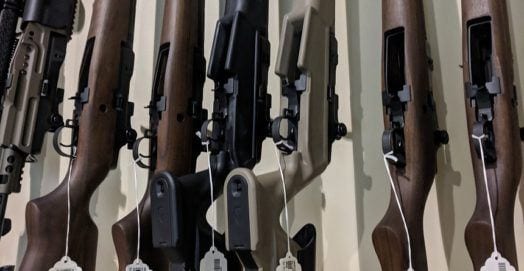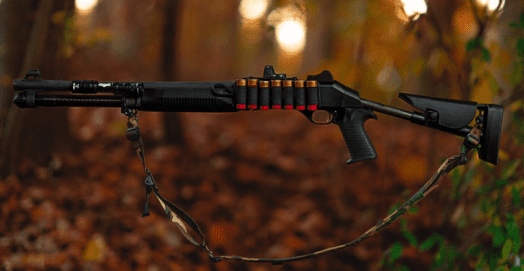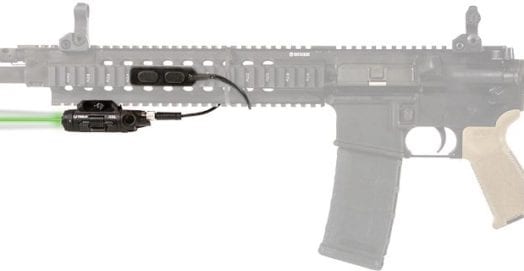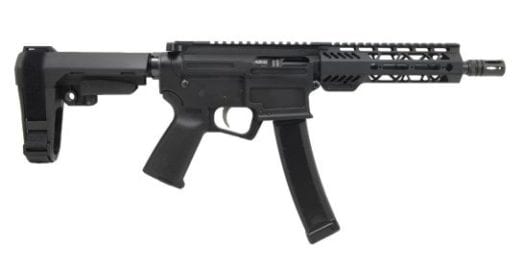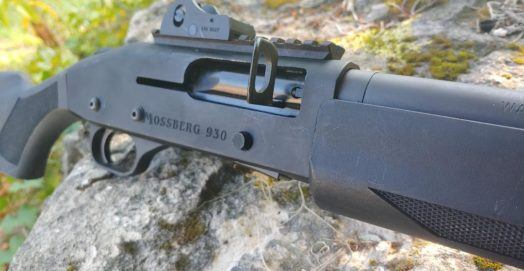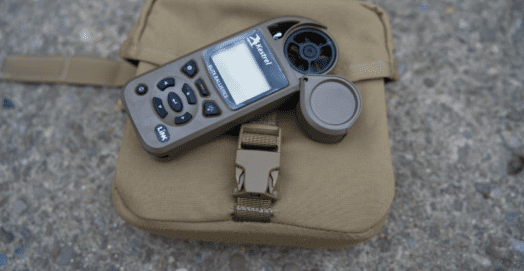The Best AR-15s: From Each Part to Complete Rifle Builds

There’s no gun in this country that’s shrouded in as much controversy as the AR-15. The media unfairly demonize the gun. At the same time, the writers of video games and Hollywood blockbusters wildly inflate the rifle’s lethality. For those of us who respect the AR, the rifle is much more.
The AR-15 is a gun that can put meat on the table. It is an ideal platform for self-defense. It is equally at home on the field of battle as it is at the range and it has come to symbolize the fight to preserve the Second Amendment.
Still, if you’re new to the AR-15 platform, there’s a lot of jargon to make sense of. Your local gun shop is likely to have AR-15s that will sell for somewhere around $700. They may also have ARs that sell for closer to $1,500. Someone may walk out with a special order that costs well over $3,000. And all three guns will look alike to the novice.
So what sets them apart? The price tags, sure, but what else? Let’s dissect some of the most common features.
Contents
The Beginning
What began as simple sketches back in the 1950s has blown up into a stand-alone class of gun. Eugene Stoner began the development in 1955 with ArmaLite’s AR-10, a select-fire .308 meant to replace the heavy military rifles of the era.
From the fully automatic .308 came a lithe semi-automatic rifle that has come to be the emblem of American gun rights.
What’s behind the AR-15’s success remains a matter of intense debate. Some of the rifle’s features stand out and have been present its inception. Yet the firearms industry continues to refine the design through advances in material science, ergonomics, and performance.
We’ll start with the size. While the gun wasn’t originally chambered for the 5.56, it didn’t take long for the tiny round to win out. The 5.56 is lighter than the .30-06 and the .308 rounds that preceded it in American fighting rifles. This means a soldier can carry more rounds. Magazines can hold 30 rounds, at least, without impacting the balance of the rifle. In turn, soldiers could carry more rounds.
Because the 5.56 round is smaller than the .308, the rifle itself can be more compact. While early M-16 variants were mostly long-barreled rifles, the design still allowed for the use of materials like aluminum and plastic, both of which make the gun easier to carry over long distances, and easier for battle-fatigued soldiers to get on target.
But there are hundreds of examples of light rifle designs, most of which are capable of delivering solid accuracy from lethal ammunition. So why did the AR platform rise to the top?
The answer is easy enough. The AR-15 is a truly modular design. Every single piece of an AR-15 (in theory, at least) can be removed and replaced with another, off the shelf piece, with minimal fitting. This made it ideal for military usage, as parts could be outsourced to different manufacturers, ones who specialized in alloyed metals, or barrels, or plastics. Then people with little-to-no gunsmithing skills could assemble the pieces with highly dependable results.
This is, in effect, the true genius of America’s rifle.
Modularity on the civilian side has less to do with the economy of scale and everything to do with customization. The AR-15, for most of us, is somewhat like a Barbie doll. The metaphor may make you cringe, but it is apt so stick with me. Most of us start with a stock gun and then begin stripping off parts and furniture and adding new ones.
One AR-15 lower can become the host to multiple uppers. Caliber conversions are easy. Upgraded parts are a no-brainer. Even barrel length can be tailored to the intended use, all off the same lower receiver.
Hoping to get more bang for your buck on a Southern whitetail hunt? Slap on a 20-inch barrel and increase the rifle’s power and range. Once you’re back home, you can switch out for a carbine length upper, or even a short barrel (if you have the appropriate paperwork from Uncle Sam) and your rifle is ready for home defense.
And caliber variations are limited only by your imagination. From the lowly rimfire to the hulk-like .50 Beowolf, the AR has been chambered to fire just about every caliber available in your local gun shop, and some that aren’t. The basic AR-15 pattern is so popular that even some shotgun manufacturers try to capitalize on the craze.
For the purposes of this study, we’ll look at the 5.56. A rifle chambered in 5.56x45mm will also function with the .223 Remington. The .223 operates at a lower pressure than the 5.56—so it can safely be fired from a rifle rated for 5.56. It isn’t safe to assume that the reverse is true.
Components
At the core, the AR-15 breaks down into several component parts groups. Each group of parts does something different for the rifle. Basically, this is the groundwork that makes the AR-15 like a big set of legos for gun enthusiasts.
Let’s look over some of the different types of parts you’ll need to compile to make sure you either build or own an effective AR-15.
1. Barrels

There’s always a barrel. This attaches to the upper receiver. Barrels are common in lengths as short as seven inches (which will require a tax stamp if it is on a rifle) and run out to 20 and even 22 inches.
Longer barrels allow for more internal gas expansion (to a point), so a bullet leaving a 20-inch barrel will be traveling faster than a bullet leaving a 10-inch barrel. The increase in length also can add to accuracy, as the bullets have more time to stabilize before they leave the barrel.
The most common barrel on the entry-level AR-15 is somewhere around the 16-inch mark. This provides an excellent length for the addition of accessories, allows the rifle to meet the minimum length as required by law, and is plenty of length for proper gas expansion internally.
It is possible to find a shorter barrel that still meets the legal limit, but these have their muzzle breaks welded on, effectively extending the length of the barrel to 16 inches.
Almost all of the guns we’ll be looking at below fall into this carbine length category.
That nomenclature may be confusing at first, but it is easy enough to discern. Guns with longer barrels (usually the older M-16 copies and guns built for long-range accuracy) are euphemistically called “rifles.” Don’t let this throw you. Anything with a rifled barrel and a proper stock is legally a rifle.
The “carbine” is still a rifle, technically, but is optimized for an ideal balance between barrel length (typically 16 inches) and maneuverability.
Barrels shorter than 16 inches fall into the “short-barreled rifle” (SBR) designation. As such, many manufacturers offer guns that are built without traditional stocks. These are classified as “pistols” by the BATFE, as they aren’t designed to be shouldered. Some of the pistols (and short-barreled rifles) will have barrels as short as seven inches. Ten-inch and 11-inch barrels are common, too.
There’s more to consider about barrels than just length. Barrel Profile is a hot topic. Some target shooters prefer heavy barrels (often called a “bull barrel”). These are thicker, heavier, and offer rigidity that translates into long-range accuracy. Most bull barrels are just under an inch in diameter.
Most carbines have a Colt Automatic Rifle (CAR) profile. This is another of the abbreviations that are often misunderstood. Colt made many of the early contract guns and used the CAR profile on their barrels. Many still think CAR means “carbine.”
In this same group of very thin barrels, you may see terms like “pencil” or Lightweight.” The designations are apt. These barrels are thin. As such, they heat up quickly. They come in at .625 of an inch in diameter.
The M4 profile, at .75 of an inch, offers more resistance to heat. It is a good happy medium. The additional weight shifts the balance of the rifle slightly forward, but it is still light enough to carry.
There’s an additional layer of technical detail present in discussions of the material construction of barrels.
Barrels are almost always made of steel. Steel is a complicated subject, one often obfuscated by proprietary alloys and trade names. Every kind of steel has a basic number code that industry insiders recognize, but marketers like to make up fancy names.
Most AR-15 barrel manufacturers prefer molybdenum steel. That’s what the first number in the four number code sequence represents: 4XXX. The next number denotes something that has been added; 41XX denotes the addition of sulfur (which helps in the machining process). The last two numbers represent the percentage of the alloy that is comprised of carbon. So 4150 would be molybdenum steel with sulfur added that is .50% carbon.
Stainless is popular, too. While great at avoiding corrosion, stainless steel isn’t as hard or durable as 4150. And the type of stainless used in these applications still requires care.
Some makers will use names in their steel descriptors, like chrome and vanadium, instead of numbers. Don’t stress over the names or numbers. Steel is one of the areas that the engineers really obsess over. Most end-users, though, have a very hard time telling the difference. And almost all of the materials in common usage are very similar in their properties and performance.
The materials coating the inside of barrels are a different story.
AR-15s are workhorses. As such, many of us don’t baby them. A good barrel lining will help increase the longevity of the gun.
Ferritic Nitrocarburizing (FNC) is tough and slick. FNC may be called by abbreviations or trade names. Look for Tennifer, Melonite or Nitride. These coatings cut down on friction as the bullets slide up the barrels and are easy to clean.
Most of the barrels you’ll find will have a simple chrome lining. While it isn’t as durable as FNC, it is less expensive and still offers solid protection. Chrome-lined barrels are still very easy to clean and they stand up to the elements nicely.
Some barrels aren’t lined at all. That’s not a problem, but these unlined barrels need TLC. I’d highly suggest keeping these barrels well lubricated while they’re in storage, and clean them after you shoot.
Another bit of nomenclature you might run into has to do with how the barrel is actually made. Cold hammer-forged barrels are exceptionally durable. The barrel is shaped by a hammer, while the steel is cold, as the name implies. This compacts the grain in the steel and makes a very durable, hard barrel.
The other option simply runs a carbide bit through a tube of steel to cut rifling. There’s nothing inherently wrong with the process, but it isn’t something manufacturers will typically brag about.
The twist rate of the rifling itself might be the last bit of somewhat inscrutable jargon. The first number in the equation is the number of twists (typically 1). The second number is how far the bullet will travel through the barrel to make that number of twists. An example—a 1:9 twist rate requires nine inches of barrel for the bullet to make one revolution.
AR-15s often have twist rates in the 1:7 or 1:9 rates. Some are even slower, like the 1:12.
Longer bullets are typically heavier and need a fast twist rate to stabilize their flight, like the 1:7 or 1:9. Shorter (usually lighter) bullets don’t need quite so much, so a 1:12 might suffice.
This isn’t an issue on guns you buy off the shelf. Most manufacturers pair the appropriate barrel with the ammo they assume you will be shooting. Most carbine owners will blow through cases of budget 5.56 and rarely give the twist rate a second thought.
If you are building your own, you will need to decide. If you are looking for a rifle that will shoot incredibly tight groups, pairing your rifle’s twist rate with an appropriate grain weight is imperative. Most of us do simple range-time experiments. Buy many different kinds of ammo and test all of them, then run with the one that provides the best result, regardless of the twist rate.
2. Uppers

Barrels can be swapped out on an AR-pattern rifle much more easily than they can on many other rifles. The genius is the way the barrel is simply pressed into an “upper.”
The upper receiver holds the bolt and bolt carrier. There are a few variations that are common in uppers. Despite the “receiver” designation in the title, these are not legally considered to be a “firearm” by the feds. As such, uppers can be bought and sold without any additional paperwork.
Most of them are made of aluminum. Some have built-in carry handles on them, like the old M-16, but most are simply topped with a grooved aluminum rail.
The uppers on most modern ARs will have a forward assist plunger built-in. This is the fail-safe for a round that hasn’t seated all the way home when the bolt closes.
Other than the available rainbow of color choices, there is usually very little variation in uppers. They have to be modular inside, of course, and have to pair with other modular parts on four of their six sides externally, which cuts down on the size of the creative canvas—so to speak.
3. Lowers

The upper, with its guts, sits on top of the lower receiver, which holds the fire control group and all of its component parts (like the trigger, hammer, seer, etc.).
Lowers come in a variety of exterior shapes. Most are aluminum with a plain black finish. Some companies mess with the angles of the lower’s edges. Some get funky with magazine well design. Some companies are even making these from plastics.
The most important designation of quality comes from the initial stage of receiver construction. Most begin with aluminum cast to the desired shape. More expensive rifles begin with a hardened billet and are milled to the desired shape. They both function in exactly the same way.
The main thing to remember about the lower is that this, according to the BATFE, is the actual firearm. This piece contains the serial number. It doesn’t matter if you buy an AR-15 that is range-ready, or if you buy an empty hunk of aluminum. The lower is a firearm, technically speaking.
4. Furniture

The term furniture is slightly deceptive. We’re talking about three main components of the gun. The stock, the grip, and the forend.
Providing a catalog of the available options for AR-15 forends is about as absurd as trying to catalog Barbie’s available wardrobe. Some will call these forends, others say handguards. Others will simply call them rails.
Forends (on the high end) are available in checked wood. On the low end are the clam-shell plastics.
The middle is the sweet spot for most AR owners. Most want the option of adding an accessory or two to the front of the rifle. As such, most forend designs incorporate Picatinny rail sections.
Pic rails, though, aren’t for everyone. New attachment methods are constantly in the works. Again, the Barbie fashion metaphor is fitting.
The old Picatinny rail system works great. When milled from aluminum, it can add weight to a rifle. So there has been an almost constant push to build-a-better-mousetrap.
There are several other options. Keymod rails are lighter and easy to find, though all of your extras (lights, lasers, vertical grips) will have to have keymod attachments. This isn’t always possible, so companies make small pic rails that attach with Keymod fasteners.
Some companies, like Magpul, have really maximized the proprietary nature of their own hardware with systems like MLOK and MOE. Both of these are fabulous and very lightweight.
The problem is rooted in open-source design. If you choose to add furniture that is protected by copyright, expect to have your add-on choices limited. Open source platforms simply have to catch on and then they scale according to demand.
Grips are also easy to swap out. If you have large hands, the AR-15 might feel small in your mitts. A larger grip can fix that. Or maybe you want to keep a cleaning kit or extra batteries in your grip—that’s easy, too.
5. Stocks

The backend of the gun is no less important. Most of the early versions of the AR had a fixed stock, and the retro fixed stocks are making a huge comeback in the last few years. But most are adjustable.
There are four typical styles you’ll see out in the wild. The fixed stock is the first. Almost every off-the-shelf AR is going to have a simple triangular adjustable stock. These move a few inches, at most, and work fine.
Hunting guns and long-range rifles might have a more complex stock that will be adjustable in many ways. The cheekpiece may move, as will the comb. Shooters can get behind these and really dial them in.
Lightweight rifles may have minimalist stocks that drop features as they drop weight. These are slick and usually shift the balance of a rifle forward. They’re most common on SBRs.
6. Sights

Many carbines have a front sight that doubles as a gas port for the barrel. This built-in limits creativity, but is convenient.
Others rely on a small section of rail on top of the gas block, or simply move the front sight up to the forend itself. The exceptions are the canted sights that hold off the side, away from an optic that might get in the way.
Almost all of the add-on sights are popular with AR-15 owners are of the flip-up variety. They stow easily, so they don’t get caught on clothes or obstacles, but are there and zeroed when needed. Like everything else with the AR-15, these can be made of steel, polymer, or aluminum.
AR-15 owners typically have some sort of brand loyalty that’s in evidence on their rifles. Magpul is the industry leader. Companies like Tapco offer more economical options. Between these two industry giants are countless small shops that are milling brilliant add-ons.
7. Optics

There are numerous options for use on ARs. Some companies make scopes that are specifically optimized for carbine length AR-15s chambered in .223, but there’s no need to get that specific. Most optics have found a home up top at one time or another.
Red dots and holographic sights are popular for home defense and close-quarters fighting guns. Red dots are all about the speed of target acquisition and not surgical precision.
Many competitive shooters use high-end scopes like ACOGs with minimal magnification. The 1-4 and 1-6 models are the most versatile. These allow for close precision and mid-range accuracy. While not as fast as red dots, they’re still fast for those who practice with them regularly.
Magnified scopes (and even paired magnifiers) allow for the .223 to reach some respectable distances.
8. Lights & Lasers

The forend is almost always where you’ll put lights and most lasers. Many civilians who trust their AR-15s for home defense like lights mounted on their rifles. After-all, their hands are full.
Some lights are specifically designed to mount directly to the gun itself. These are often referred to as weapon-lights.
Others mount in small frames that hold more typically shaped flashlights. Both work well.
Light output is measured in lumens. The higher the number, the brighter the light will be. A word of warning here—test your light’s brightness in real-world darkness. The last thing you want is to be blinded by a light that is too bright at the moment that you need it most.
If you are looking for an even easier way to get on target, look at the variety of red and green lasers.
All the extras.
Like a good Hollywood blockbuster, the AR-15 is the star of the show. Yet the gun wouldn’t be what it is without its supporting cast.
One of the first things many add to the gun is a sling. That requires a sling mount. Many ARs have Quick Detach points built into the furniture. If not, there are aftermarket add-ons for many other designs. Hooks are the most popular.
Compact rifles, SBRs, and many AR pistols are carried on single-point slings. Longer rifles and carbines are often carried on two-point versions.
9. Gas Systems

As we are primarily focusing on the typical carbine, direct impingement is the norm. When the gas expands in the barrel, a small portion escapes into a tiny hole (usually below the front sight). As it leaves the barrel, it enters the gas block and then the gas tube, which sends it back into the upper receiver.
That gas pushes the bolt back, ejecting the spent case. As the bolt travels backward, it compresses a spring in the buffer tube, which will send the bolt back into battery.
It is messy but reliable. The gas carries back bits of burnt powder and other grime that you’ll get to clean out soon enough.
The Kalashnikov rifles, like the AK, run on a piston. The gas leaves the barrel in a similar fashion, but there’s a rod between the gas and the bolt. This piston is supposed to keep the guts cleaner, longer.
Some AR-15s have piston operating systems, too. They work reliably well, but deviate from the true heart of the AR-15 as piston guns are not wholly modular (at least not with other direct impingement AR-15s).
Buying Off The Shelf
Enough of the rigmarole. As you have no doubt picked up on, the AR-15 comes in a wide variety of configurations, each of which has some pretty standard elements combined with an array of features meant to enhance the gun’s performance.
So how do you tell them apart? This is a key question for many who are making their first black-rifle purchase. All of the AR-15s look pretty similar. All of them are capable of putting lead on a target.
Check out the price tag. That’s what most of us will do first.
Almost all gun stores build some room in their pricing for haggling. If there’s no politically motivated panic buying in effect, you can expect to pay less than the Manufacturer’s Suggested Retail Price (MSRP). Many shops will set their prices to what’s called Minimum Advertised Price (MAP), but can sell guns to individuals for less (assuming they don’t ever advertise that price break).
Budget Friendly Around $500
At the $500 mark, or well below during some sales, you can expect a decent working-class carbine. Most of these will shoot a 2-inch group at 100 yards, all day long.
In almost every case, the barrel won’t be lined. The lower and upper will be cast aluminum and not milled from a billet. The finish is going to be black….
There may be a railed forend, though most will have a simple clamshell heat shield. The rail on the top of the upper will suffice for optics, but there will be few extras. The furniture will not have a brand name attached.
How do they shoot? I can say with the utmost confidence that these guns perform well. Thinner unlined barrels will need regular cleaning, as will the working parts in the upper and lower. But these are AR-15s, just like their more expensive cousins below.
For those looking for an entry-level gun, I’d stand behind these guns.
1. Palmetto State Armory 16” M4 Nato

The Palmetto State Armory 16” M4 Nato is just what the name describes. The gun has a 4150V barrel that’s cut to an M4 profile. Just about everything on this rifle is a tribute to the existing M4 pattern rifles.
And you can’t go wrong with PSA. The company is known for its parts and their devoted following in the DIY community. They are far from the most expensive and elite brand, but that, too, has earned them points with many who don’t buy into the hype that surrounds some other companies.
This one even comes with Magpul furniture, something you don’t often find on the entry-level guns.
2. Inter Ordnance M215 KeyMod 15” 556 NATO

Don’t let it fool you, though. There’s still a 16” barrel under the hood. It has a 1:8 twist, too.
The M215 is light, just over six pounds, but you can expect to add a good pound, at least, with sights, an optic of some sort, and a sling.
As for the company, I.O. has been around for a while. They specialize in value. They don’t provide all of the extras some companies do, but the guns work and aren’t going to break the bank.
3. DPMS Oracle

The DPMS Oracle is a bit more bare-bones. The forend, though, is easy to replace if you want more rail space, and something the oracle offers that some of these others do not is the small section of rail on the gas block.
And DPMS has a solid reputation for making dependable guns. While this may not stand out as a flashy entry-level AR-15, this is a solid choice for those who want a gun that will run, out of the box, with minimal additions.
In fact, all this rifle needs is an optic, or a pair of sights, or both. And there are lots of homespun guns that run on DPMS receivers; they make a great platform for anyone looking on building up.
4. Del-Ton Sport-Mod 2

The Del-Ton Sport-Mod 2 is another leading option on this shortlist. The Sport-Mod 2 comes with a fixed front sight and a collapsible rear sight. For those who want to hit the range with no other expense (other than ammo), this is an ideal option.
And unlike some of the other brands in this article, Del-Ton really specializes in AR-15s. They’re not a trendy name, but I’ve spent time behind several and I have no complaints.
Like some of the other M4 clones, this one has a 16” barrel with a 1:9 twist rate. The handguards are basic, but they do their job as a heat shield. The stock, like many of the others, moves into six different positions, which is nice if you’re on the big (or small) end.
5. Diamondback DB15

Diamondback is another maker that really embraces the lower end of the market. Their pistols and rifles are never expensive and are popular with working-class shooters. The DB15 is no exception.
I’ve run several competitions with a DB15 and have no complaints about the way the gun functions. In many ways, it is a bog-standard starting point for the AR-15, but it is reliable as accurate as many much-more-expensive guns.
There are few aftermarket parts on this one, though the stock is made by ATI. The M4 profile on the barrel adds a bit of weight, but the whole gun is anodized or coated in Melonite. These are durable, dependable, and easy to find at your local FFL.
Best AR-15’s Under $1,000
A $500 price jump might seem extreme. In the AR pricing, it isn’t all that much. Some of these rifles will come in well under that mark. Others will push the $999.99 boundary in an attempt to stay under, too.
There are two factors at play in this list. The first, of course, is the increase in features. Many of these guns will have better coatings, lined barrels, great furniture, QD sling mounts, improved triggers…
The second consideration is fashion. Some of these guns makers have reputable names that command higher prices. Some gun companies enjoy an almost cult-like popularity that helps build out their pricing.
Supply and demand, though, works well. If you find one of these guns on the shelf at your local gun shop, you have room to negotiate.
Here is a brutal truth. These guns will shoot as reliably as the cheaper ones above. You may notice an increase in accuracy at 100 yards, but it will be modest. Even when they combine better parts, as all of these do, the increase in performance is marginal precisely because the bar for the AR is set so high, to begin with.
The standouts in this category? The list is incredibly long. Some of the bigger names in the industry come in at this price point, as do many of the smaller makers.
1. Colt M4 Carbine

If you have the spending money, start with a Colt. You won’t regret the decision. Colt is, after all, the company that fulfilled many of the government contracts for the entire history of the rifle.
Astute observers, though, may note that this gun looks strikingly similar to the others in this list, down to the clamshell heat-shield handguards. The barrel is 16” inches. The front sight is fixed…. So what is it that makes this special?
For one, it is a Colt. Welcome to reality, folks. You will pay more for this rifle in this configuration because it is a Colt. Yet you will get something intangible, too.
While there’s no guarantee that this gun will last longer, or shoot better than those at the $500 mark, Colt has made a lot of these guns. They know what they’re doing. Their processes are perfected, and people who specialize in exactly this assemble the guns. As such, this rifle will hold its value very well.
2. Smith & Wesson M&P 15 Sport II

Smith & Wesson may be known for their exquisite wheel guns, but they make some badass pistols and rifles, too. Smith is known for its law enforcement work, and many departments field M&P pistols and rifles, too.
The Smith AR-15s are also good at holding their value. The company is big enough to have great R&D and testing facilities. And their workers make careers with the company.
The M&P 15 Sport II, in particular, has one upgrade over some of the other guns in this list. They are sporting M-LOK handguards from Magpul. The rest of the rifle should look familiar to those who have been scrolling. The stock is a standard six position model, and the gas block is railed.
The phrase optics-ready typically means you’ll need an optic, or sights, to use the rifle effectively, so keep that extra expense in mind.
3. Springfield Armory Saint 5.56

Springfield Armory is new to the AR-15 game. They launched in 2016, just before the election, and had rifles on shelves in anticipation of political upheaval. That didn’t happen, though, but the Saint hasn’t gone away.
Springfield’s other guns typically fall into three categories: 1911s, polymer pistols, and M-14 pattern rifles. What they do, they do well, and their customer service is excellent. They’re nowhere near the size of some of the other companies in this list, and that shows in the company’s accessibility.
The Saint has some serious upgrades, too. Outside, you’ll find Bravo Company grips and trigger guards. The stock and forend are Bravo Company’s designs, too. Inside, Springfield has coated the trigger with nickel-boron, which cuts out the grit common to most AR triggers. They’ve also modified the weight of the buffer to help with the already modest recoil.
The Saint, like some of the others on this list, is far more likely to appeal to the folks who aren’t going to make too many additions or substitutions and is ready to roll as-is.
4. Ruger AR-556

Ruger makes excellent rifles. The company is spread across the U.S., but they do most of their own manufacturing. While they are also new to the AR-15 market, they entered with a big bang. They are more famous for some of their earlier firearms, including the 10/22.
Ruger is the working-man’s gun. The AR-556 is no exception. It lacks the frills of many rifles in this price point, but it is no less attractive. The heat shields seem somewhat generic for a Ruger, but no worries. They’re even using their own branded furniture and sights.
While the gun may not set your heart to racing, it is a workhorse of an AR-15. In honor of its military roots, this one even has a bayonet lug.
5. The Bravo Company M4

The last company in this line-up may not be as familiar to those of you who are new to the Ar-15. They’re innovators, though, and Bravo Company is one of the ones I was talking about earlier in this article. They make the pieces and parts that other companies use to build their own rifles (like the Springfield above).
Bravo Company is the first of our high fashion guns. Their production numbers are much smaller, and this is the company many end up eyeing when they start looking for their second AR-15. And if you come across one at a good price, don’t pass it up.
The BCM M4 Mod 0 Carbine is a gun that appeals to those who geek out over their ARs. All of the parts are inspected and tested. The barrel and the chamber are chrome lined. The only part on this gun that you are likely to wear out is the barrel itself, and that will take many thousands of rounds to accomplish.
Best AR-15s Under $1,500
Once you cross the $1,000 mark, AR-15s begin to branch out toward their respective specialties. You will find long-range hunters, guns dedicated to 3-gun competition, numerous builds with boutique triggers and the latest furniture….
As you cross this price point, you can begin to expect increases in accuracy. Many guns in this group will shoot a 1-inch group, or better, at 100 yards. I’m not going to break these out in extreme detail, but there is a number worth mentioning in this bucket.
Others in this category miraculously shed pounds. The first time you hold a 6 pound AR-15 is somewhat magical.
Rock River makes solid tactical rifles in various categories, though it is their sporting guns that really stand out. Rock River’s triggers are superb, and they make great use of heavy barrels. If you want a long-range AR-15 in any number of available calibers, start here.
The 16” Varmint A4 LAR-15 is a beast. With its stainless bull barrel, this is a tack driver. The gun is ideal for use with a bi-pod and a short magazine but needs to be topped with a really clear high powered scope.
You can also expect to find more of the names typically associated with government contracts.
Sig Sauer is a growing force in military contract work. Their pistols (including the new sidearm of the US military) have a proven record of service, and their rifles are in use with agencies around the world.
Sig is known for taking their guns away from the original modularity on which the AR-15 was founded. That’s not to say that they’re not top-of-the-line. They are, but some of their guns that look like ARs, aren’t.
The SIG716 is, for the most part. The gun has some unique features, though, like the adjustable gas flow. If you are shooting suppressed, or really hot rounds, this will help stabilize the speed of the bolt.
Heckler & Koch is another powerhouse familiar to western militaries. They make AR-15s that can stand with any in this category, though the company is far better known for making the rifles that compete with the AR-15.
The H&K MR556A1 is a lovely take on the classic carbine. Pick it up, though, and you’ll feel the heft. This gun weighs more than eight pounds, naked. Everything’s where it should be, though, from the KeyMod forend to the ergonomic grip.
Their low-end guns come in close to the $1,500 mark at retail. They go up from there. But there’s a good reason. DD hasn’t simply traded on its name; the company has some unique takes on the AR.
The DDM4 V11 is where many start. One of the things that set apart the DD guns is their use of a soft rubber on some of their furniture. This gives the gun a warmer feel, and it isn’t as abrasive during recoil. They’ve also managed to cut down on mass while also linking pieces together in a way that prevents snags and hang-ups (look at the stack on this one for an example).
$1500 and Up
There are some exquisite small-batch guns. Hand-built rifles can be works of art. It isn’t uncommon to see big companies like Daniel Defense making rifles that sell in the $3,000 range, or higher, but don’t pass over the boutique makers either.
Again, not going to dive into too much detail here, but if you’re in the market, I’d recommend looking at these:
LWRC, LaRue, Lewis Machine and Tool, Noveske, POF…. The list is long. Even Turnbull, a company not known for their tactical builds, has gotten into the game.
The Turnbull AR-15s are an acquired taste, for sure.
Is there anything about the way those guns function? That is a very contentious debate.
Think of it this way. I began this piece with a Barbie metaphor. The more you dress her up, the more expensive the doll becomes. The same holds true for the AR-15.
Maybe it would be better to talk about these guns outside of the confines of the extended metaphor. Let’s pull back and look at the situation as it stands today.
There are hundreds of companies making AR-15s, parts, furniture, barrels, triggers, and optics. Hundreds. That’s no exaggeration. During the Obama years, there were well over 200 companies making (or assembling) complete rifles.
Some of those companies went under when sales slumped after the 2016 election. The rest began downsizing and streamlining production. Many of these companies buy their parts from suppliers that also supply competing companies. This, after all, is the genius of the AR-15. Modularity makes assembly easy.
What this means is that if you go into your local gun store and pick up three AR-15s, odds are those three guns will have parts that are made by the same subcontractors.
Many of these gun companies are branding their AR-15s with their own logos, even though they don’t make all of the parts themselves. So how are we, the end-users, really expected to know just how the guns are unique or different?
This brings us to the last question for this long list.
Want To Build Your Own?
You can. It is easy. A quick YouTube search will show you countless videos on assembling parts. Many of the big suppliers have a wide selection of AR lowers, AR lower parts kits, upper receivers, barrels, grips, triggers, handguards or forends, rails, sling mounts… you want it, it is there for you.
The only piece you actually have to buy from a gun shop is the lower receiver. As I mentioned earlier, this is the serialized part and the piece that the ATF considers to be a “firearm.” The rest of the pieces can be picked up in gun shops, too, or online.
The real reason why I’d recommend that a true beginner should buy a complete rifle instead of building one from scratch is that there’s no end to the money you’ll spend if you get sucked into the DIY hobby. There are specific tools you’ll need for the job, and tools don’t come cheap.
The parts themselves aren’t exactly cheap, either. When a company the size of Smith & Wesson buys parts, they enjoy the economy of scale. They buy in bulk. It is much less expensive that way. When you buy one barrel, you will pay for the privilege.
I’ve built AR-15s from the ground up. I’ve bought new rifles, too. In every case, I paid more for the DIY version of the AR. It would have been cheaper to buy a new rifle off the shelf rather than buy all of the parts individually.
Should You Build Your Own?
This is the deep philosophical paradox for those of us who love this gun. The AR-15 is a modular rifle that is meant to be ubiquitous. Parts were, and are, designed to be interchanged without significant modification. It is supposed to be mass-produced, and exactly the same in form and function from one gun to the next. That, after all, is crucial for military applications.
Civilians, though, have taken the gun and made it their own. We’re not in any way confined to the generic form or function of the rifle, as Stoner imagined it so many years ago.
For us, the AR-15 has become a canvas. While many are content with the standard black carbine set up, iron sights and all, the rest of us begin tweaking from day one with our new guns.
Customization is at the heart of the AR-15. By building it yourself, you can get exactly the gun you want. Just look at my go-to carbine. It is a fairly pedestrian set-up, only it has an extremely long forend. I’m tall, and I have gangly monkey arms. I’ve never picked up an off-the-shelf carbine that had enough upfront for me to shoot like I prefer to shoot, so I had to knock off a traditional front sight gas block, add the long free-float forend, and even put on a flash-suppressing muzzle device to knock back some of the flame.
Like many AR-15s out there in the wild, it isn’t pretty. It runs like a champ, though, and fits me perfectly.
And what I’ve found is that it is simply one of many. If you’re new to the AR-15, understand that the gun is addictive. I know a lot of folks who own AR-15s, and I can’t name a single one of them who only has one AR.
